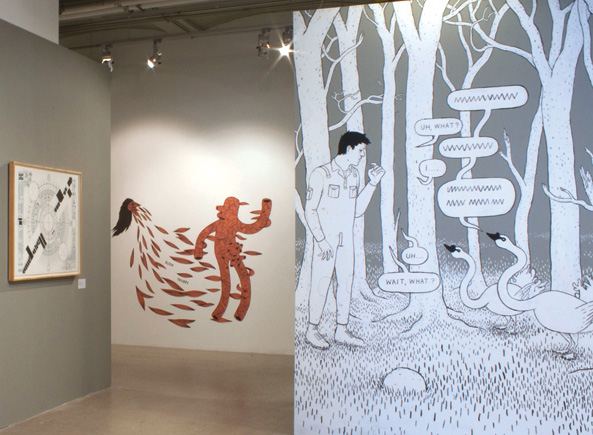
http://fnewsmagazine.com/2012/11/jerry-saltz-art-fairs-and-expo-chicago/expochicago2012-dialogues-4/
Remember when art galleries kept trying to slap graffiti on the walls and call it “urban folk art?” No? Well, that’s because when elements of counterculture are taken out of the context from which they spawned, they are quickly devoured by pop culture zombies and subsequently gurgled back up as contrived, meaningless fads that are eventually exiled to the Island of Bad Ideas. (Fingers crossed that Warped Tour follows suit.)
Needless to say, I was skeptical about “CartoonInk! Emerging Comics In Context.” Prior to seeing the show, I couldn’t help but think that a better title might be, “CartoonInk! Emerging Comics Out Of Context.” (Insert “don’t judge a book by its cover” cliché here.) After experiencing the show, I realized that the very magic of skillful cartooning lies in its ability to transform the real world into a realm wherein conventional rules need not apply.
Curated by SAIC faculty Christa Donner, Jeremy Tinder, and former faculty member Surabhi Ghosh, the show metamorphoses the stark, grey walls of The Betty Rymer Gallery into a lively carnival of contemporary comic art. The exhibit showcases a collection of artists – big-name cartoonists, SAIC faculty, alumni and current students – whose works encourage dialogue about evolving cross-disciplinary aspects of the comics medium. “With ‘CartoonInk!,’ we wanted to celebrate the multiple ways in which comics can and do exist,” explains Ghosh, who, along with Donner and Tinder, created much of SAIC’s comic art curriculum. As a result of these overlapping collaborations, the gallery becomes an eccentric universe full of screwball characters – a glum Piet Mondrian, a love-torn Cetus, a PMS-ing wolf-girl – who want nothing more than to have fun.
The curatorial success of the of the exhibition lies in its ability to illustrate the ways in which comics have grown into a remarkable art form without shoving the idea of comics as “high art” down the viewer’s throat. “Comics are fine art as much as they are literature – meaning, they are neither,” says Ghosh. In “Wraparound Cover For Acme Novelty Library #15,” seasoned cartoonist Chris Ware pokes fun at the question of comic art’s status within the canon of art. A caption within the work ironically reads, “VENDOR: Do not display in respectable bookstore anywhere near fiction, art or literature.”
As a large number of the pieces in the show contain text, the strategically placed interactive elements keep the show’s numerous highly-detailed works from becoming overwhelming. A room dedicated to the SAIC student-run comics and drawing zine, “Xerox Candy Bar,” features a cartoon version of the offbeat literary figure Richard Brautigan as the host of the exhibit. (Brautigan wrote a 1976 poem titled, “Xerox Candy Bar,” which the SAIC group later adopted as its name.)







